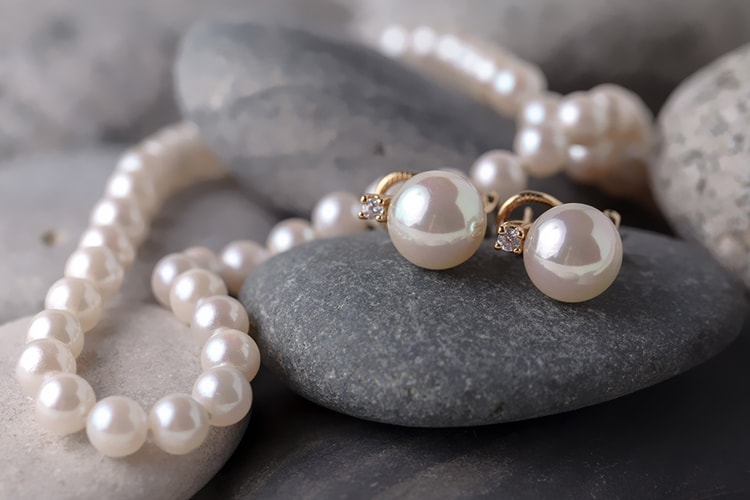Guide to Pearl Jewelry

Every woman should have pearl jewelry in her jewelry collection. Pearl quality is dependent on its source, how it was formed, and other quality factors. When shopping for pearl jewelry, your search should lead you to a professional jeweler near you, like a member of Jewelers of America, who has the expertise to ensure you get the best quality pearl jewelry for your budget. Our guide gives you pearl information to help start your search.
Pearl Jewelry: Real Versus Fake
Genuine pearls are examples of nature’s beautiful magic. They are formed when a mollusk (oyster, clam, mussel) has an irritant enter its shell; in defense, the mollusk produces layers of fluid (known as nacre, pronounced NAY-kur) around the irritant. The process takes 5-10 years, resulting in the beautiful luminous beads we cherish as pearls.
Let’s review the three types of pearls you may consider when shopping for pearl jewelry: natural, cultured, and imitation.
Natural Pearls
Natural pearls that form organically in nature are scarce — very few are on the market today. The Persian Gulf was the best source of natural pearls, but when oil was discovered around the 1930s, the Gulf waters could no longer produce pearls. Today, traditional fishing for natural pearls is still practiced in India — but the pearls harvested are often tiny and expensive.
Cultured Pearls
Cultured pearls make up the majority of pearls on the market today. The “culturing” process dates back to the late 19th century; cultured pearls are formed like natural pearls and are considered genuine pearls. An irritant is surgically placed into the mollusk in cultured pearls and protected in “pearl farms” while the pearl develops. While man can start the pearl process, it is still up to nature to determine the quality of the final pearl. Of the pearls created after a five-to-ten-year farming cycle, only 5% are of the high quality required for fine jewelry, according to the Cultured Pearl Association of America.
Imitation Pearls
Imitation pearls are the third type and have no connection to the natural pearl-making process. They are made from glass beads dipped into a solution made from fish scales. While most have a high luster, it may eventually fade.
How to Tell Real Pearls from Imitation
Professional jewelers can spot an imitation pearl from cultured pearls and will not sell you an imitation marked as real.
One way you can test a pearl as an imitation is to rub it against another pearl; imitation pearls glide across each other, but cultured pearls feel gritty because of the layers of nacre.
Many cultured pearls undergo treatments to enhance their luster or alter their color. This does not make them any less real. A professional jeweler is trained to understand and explain these treatments because they can affect the pearl jewelry’s value. Trust your pearl jewelry purchase with a jewelry store known for its educated staff and ethical standards, like jewelers who are members of Jewelers of America.
Pearl Quality Factors
Pearls are classified by origin and then graded by size, shape, nacre thickness, color, luster, surface clarity, and how they match. Here’s a quick summary of pearl quality factors to get started:
Lustre
The combination of surface brilliance and a deep-seated glow, the luster of a good-quality cultured pearl should be bright, not dull. Your reflection should be seen clearly on the surface of a cultured pearl. Any pearl that looks too chalky or dull indicates low quality.
Shape
Since cultured pearls are grown by oysters and subject to the whims of Mother Nature, it is rare to find a perfectly round cultured pearl – and these are considered the most valuable. While many prefer the perfect spheres of classic pearl jewelry, baroque pearls- those with an irregular shape- are now commonly seen in fine jewelry. Freshwater pearls from freshwater sources, like lakes and rivers, are most often baroque.
Size
Measured by their diameter in millimeters, the average cultured pearls sold today are between 7 and 7 1/2 millimeters. Generally, the larger the pearl, the more valuable it will be.
Surface
Cleanliness of the cultured pearl surface refers to the absence of disfiguring spots, bumps, or cracks. A cultured pearl with a clean surface will have a higher value than a spotted, bumpy, or cracked one.
Color
Rose Silver/White Cream Gold Blue/Gray cultured pearls occur in colors from rosé to black. While color is a matter of preference, rosé or silver/white pearls tend to look best on fair skin tones, while cream and gold-tone cultured pearls are flattering to darker complexions.
Quality Pearl Strands
- Pearls should not bunch or twist.
- Knots should be shaped uniformly and pushed snugly against both sides of every pearl.
- The silk cord should match the pearl color as closely as possible.
How to Clean & Store Pearls
- Apply cosmetics, hair sprays, and perfume before wearing pearl jewelry. When you remove the jewelry, wipe it carefully with a soft cloth to remove any traces of these substances.
- You can also wash your pearl jewelry with mild soap and water. Do not clean cultured pearls with any chemicals, abrasives, or solvents. These substances can damage your pearls.
- Always lay cultured pearl strands flat to dry. Hanging a strand may stretch the threads.
- Do not toss your cultured pearl jewelry carelessly into a purse, bag, or jewel box. A pearl’s surface is soft and can be scratched by hard metal edges or by the harder gemstones of other jewelry pieces.
- Place cultured pearls in a chamois bag or wrap them in tissue when putting them away.
- Cosmetics, perspiration, oils, and ordinary wear weaken and stretch the pearls’ threads. Bring your pearls back to your jeweler for restringing once a year. Make sure the pearls are strung with a knot between each pearl. This will prevent the loss of pearls if the string should break.
Source: Jewelers of America